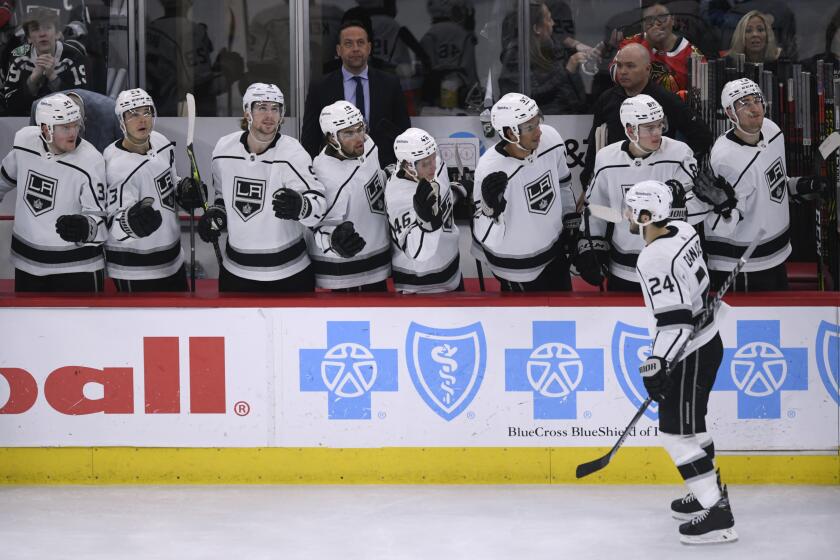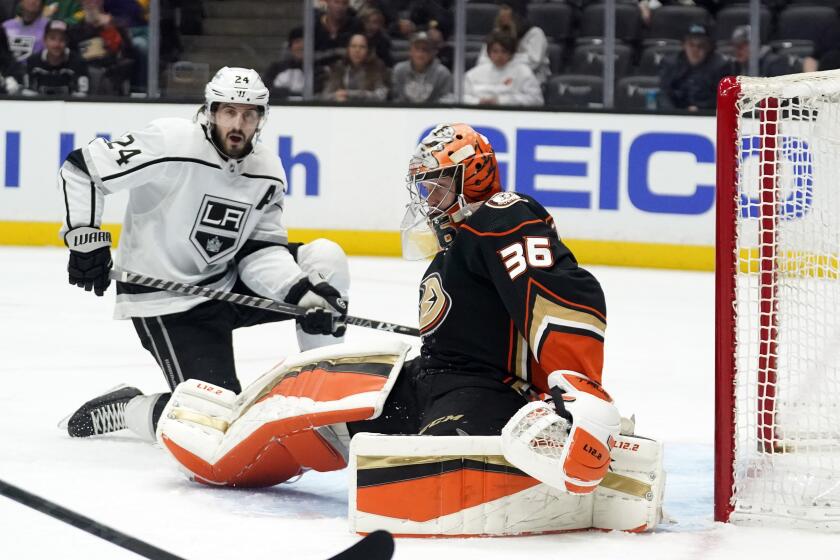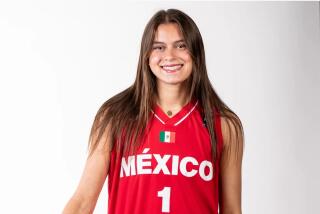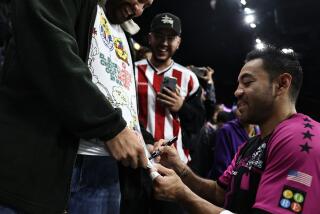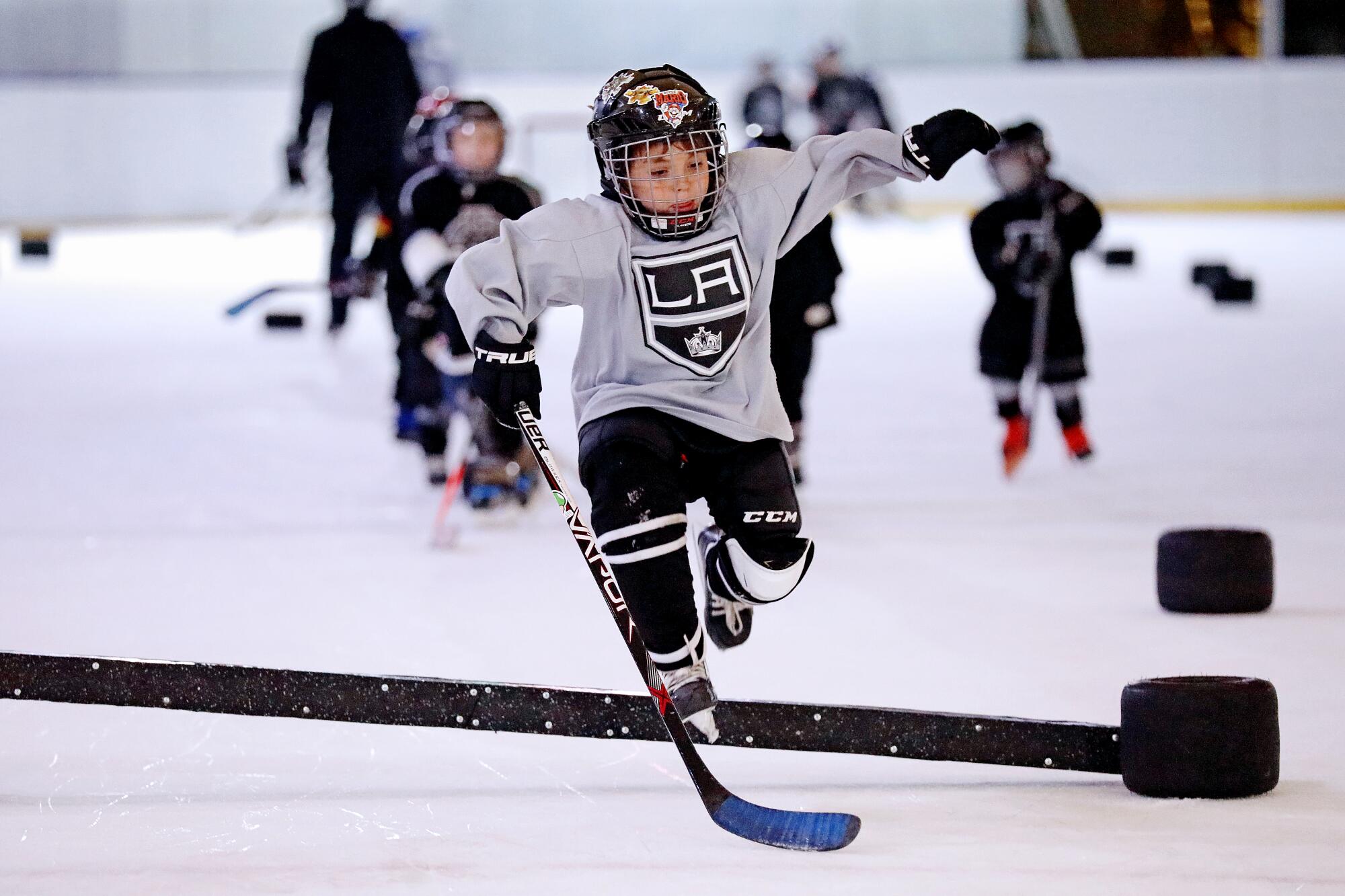
- Share via
MEXICO CITY — Ian Tarazona’s black helmet is so big it looks like an upside-down satellite dish, and his oversized hockey sweater hangs to his knees. But don’t let appearances fool you. Ian is a terror on the ice.
At one point during a recent practice, Ian skated up to another player, pulled his stick back and cracked him over the head. And that player was a teammate.
It didn’t qualify as assault because Ian is only 3 years old and the player he whacked, who was unhurt, is 5.
But it did serve as proof that it can be a challenge introducing little kids to any sport. And when the sport is hockey and the location is a shopping mall in Mexico City, that challenge only grows.
Luis González often has to suppress laughter while coaching four dozen kids, the oldest of whom are 7.
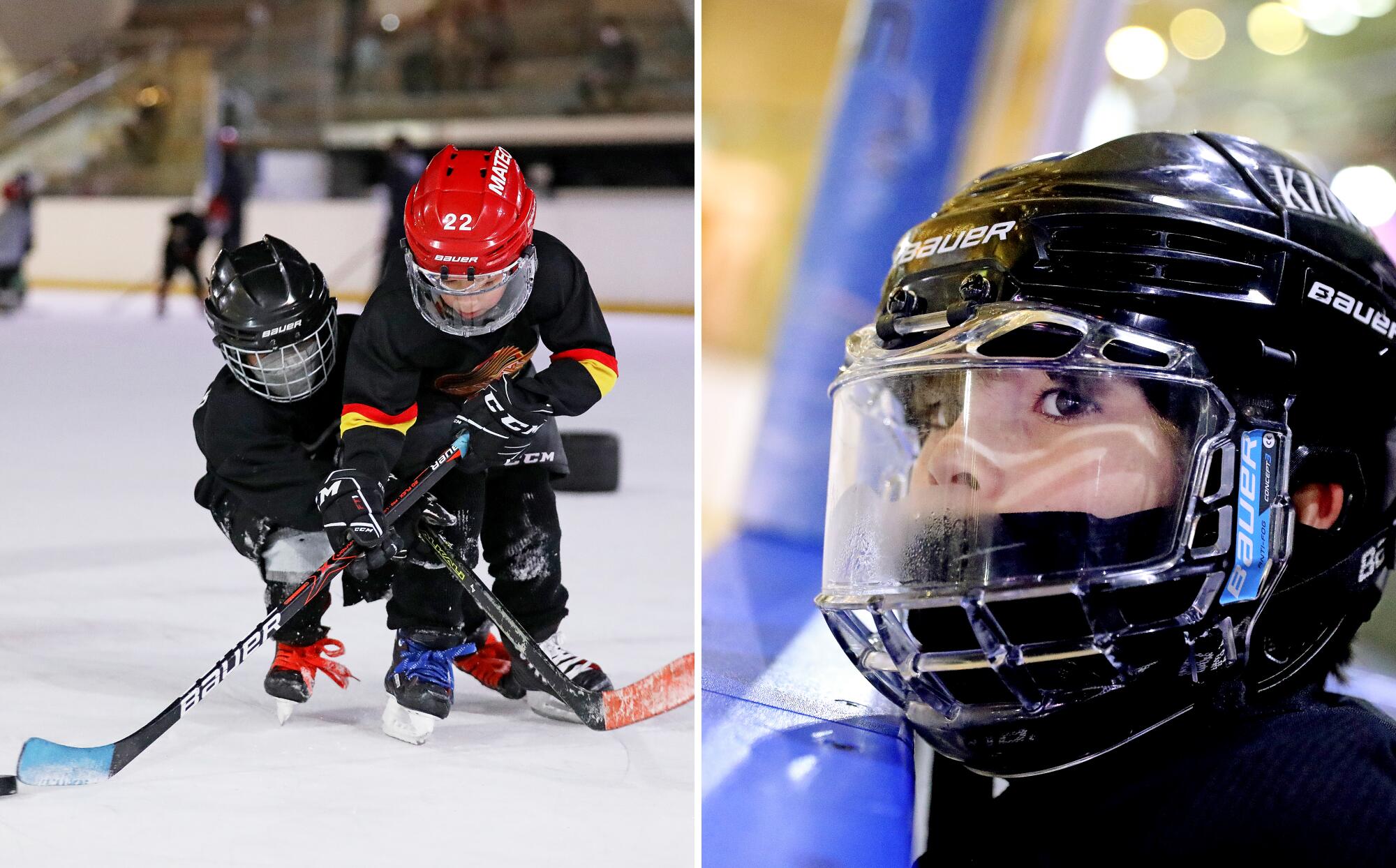
“Obviously the little kids are harder because you just have to keep them focused,” he said.
In between coaching sessions, González, who answers to Oso or “Bear,” a childhood nickname he can’t fully explain, plays for Mexico’s national ice hockey team. If you didn’t know Mexico had a national ice hockey team, don’t feel bad. Aside from the 22 players and their families, few others know either.
But the sport is gaining a foothold, or at least a toehold, in Mexico.
According to the Mexico Ice Hockey Federation — there’s one of those too — 2,690 players participate in the sport in Mexico, 1,600 of whom are junior players like the ones González coaches.
It’s a small number — and certainly an underestimate — but it still has drawn the attention of several NHL teams, which see a chance to grow the game and develop a new fan base with the hope of playing an NHL game in Mexico in the near future.
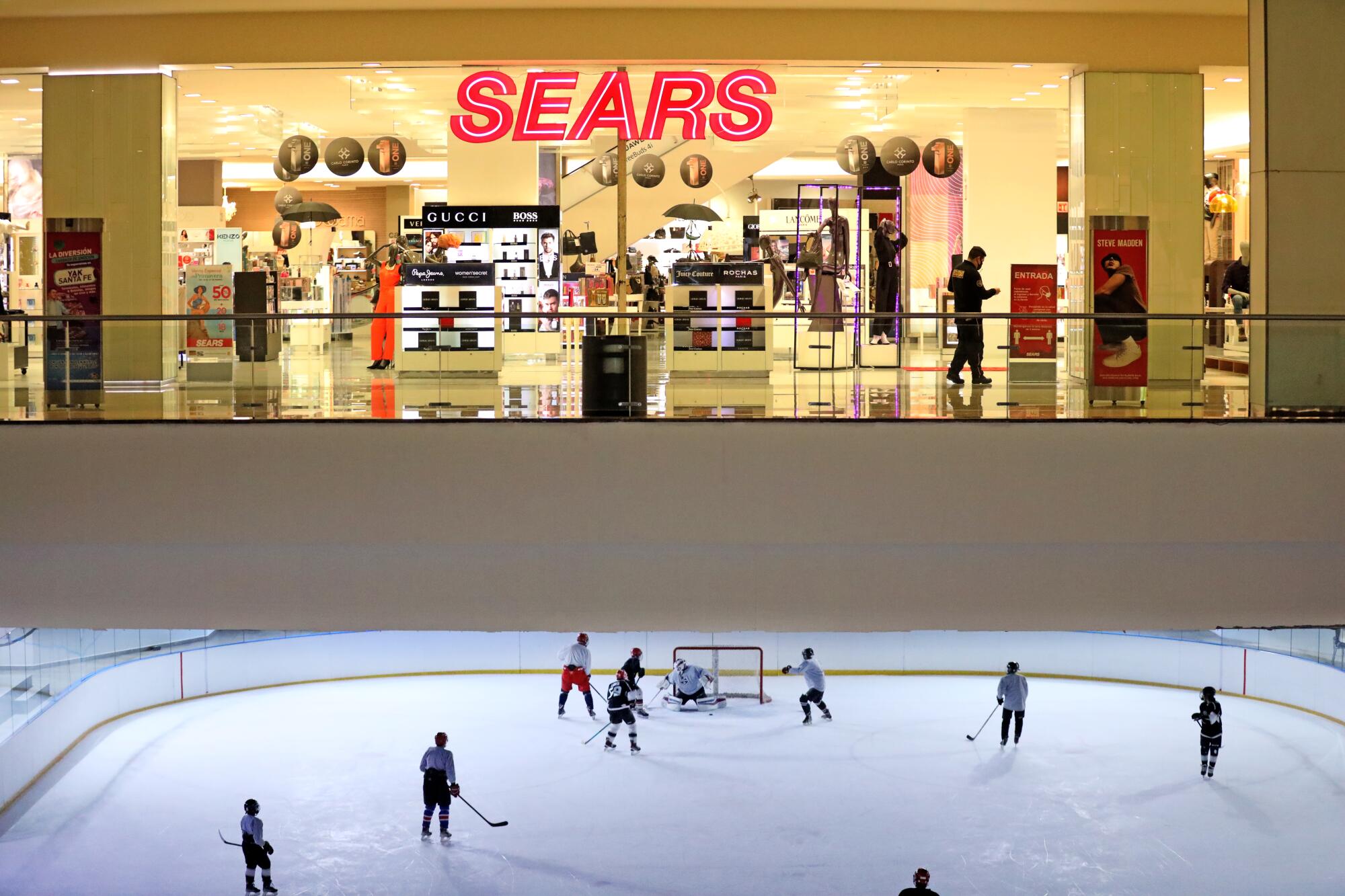
“I don’t see any reason for us to wait,” Kings President Luc Robitaille said. “It’s more important for us to go out of our way and to make it available. There’s enough kids we know like to play.”
Many of them play at an ice rink tucked into a dark corner of a Mexico City shopping mall, between a Dairy Queen and a Carl’s Jr. and below a Sears.
The Centro Santa Fe, Mexico’s second-largest shopping mall, sprawls along a major boulevard in a tony neighborhood of skyscrapers and gated apartment buildings on the western edge of the capital.
Roberto Arriaga, whose three boys all play hockey, makes the three-hour round trip there from Toluca as many as five nights a week, spending almost as much time in the chilly bleachers overlooking the ice as he does running his business in aftermarket car sales.
The Kings enter the final two weeks of the season looking to clinch their first playoff spot since 2018. Can the Ducks be the team that helps keep them out?
“A lot of friends tell me that I’m crazy,” said Arriaga, who discovered hockey almost by accident. After introducing his eldest son, Beto, to more traditional sports such as soccer without success, on a whim he put the boy in skates and hockey gear at age 6. Nine years later, Beto is still playing, as are brothers Mateo, a speedy 12-year-old defenseman, and Paulo, a skinny 10-year-old goalie so small he can fit inside the net without having to duck his helmeted head.
The two younger boys say they want to play in the NHL someday, something no Mexican has done. Arriaga chuckles when he hears that.
“At that age,” he said “it’s very good to have a dream.”
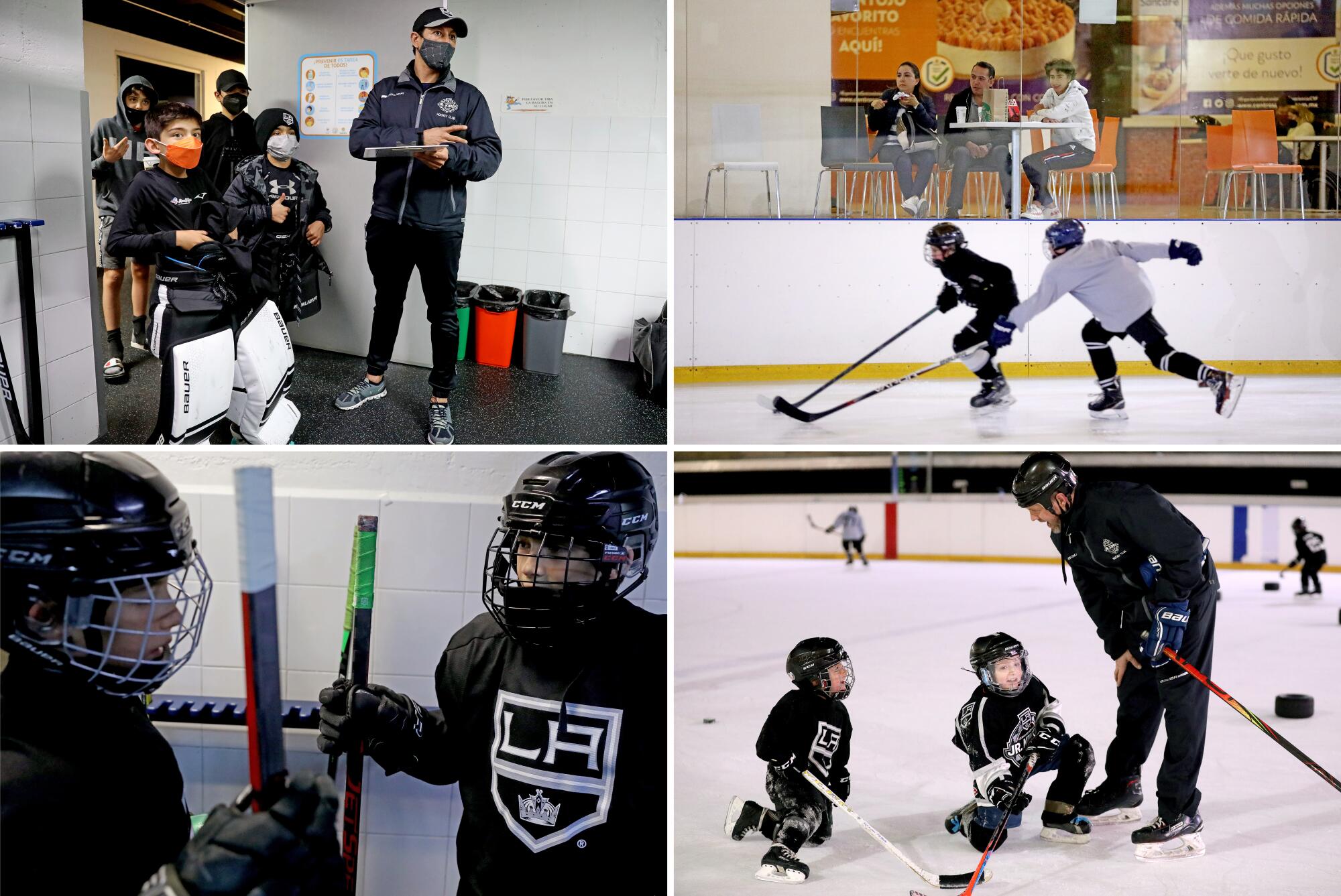
That dream isn’t what motivates the four coaches at the rink, who work with more than 140 players in six divisions, ranging in age from 3 years old through high school. Nor is producing professional players what has led the Kings to partner with the rink, offering in-person and virtual clinics as well as material assistance.
Banners touting the relationship with the L.A. team hang throughout the mall while many of the tiny players take the ice wearing black or gray Kings sweaters with a Mexican flag sewn on one shoulder.
The goal, the Kings insist, is simply to introduce the kids to hockey, teach them how to play (and sometimes to even skate) and to fuel a passion for the sport.
“It’s just a totally different vibe over there,” said Derek Armstrong, who spent six seasons playing for the Kings and is now the team’s community and hockey development specialist. “We want to bring hockey to Mexico, but we also want them to embrace it themselves and put their own little twist on it, their own little culture on it.”
That seems to be taking hold at the Santa Fe rink, where rushes up and down the ice take place at breakneck speed, with few passes and even fewer checks — physical defensive moves intended to disrupt play. In that way, Mexican hockey can sometimes look like soccer on skates.
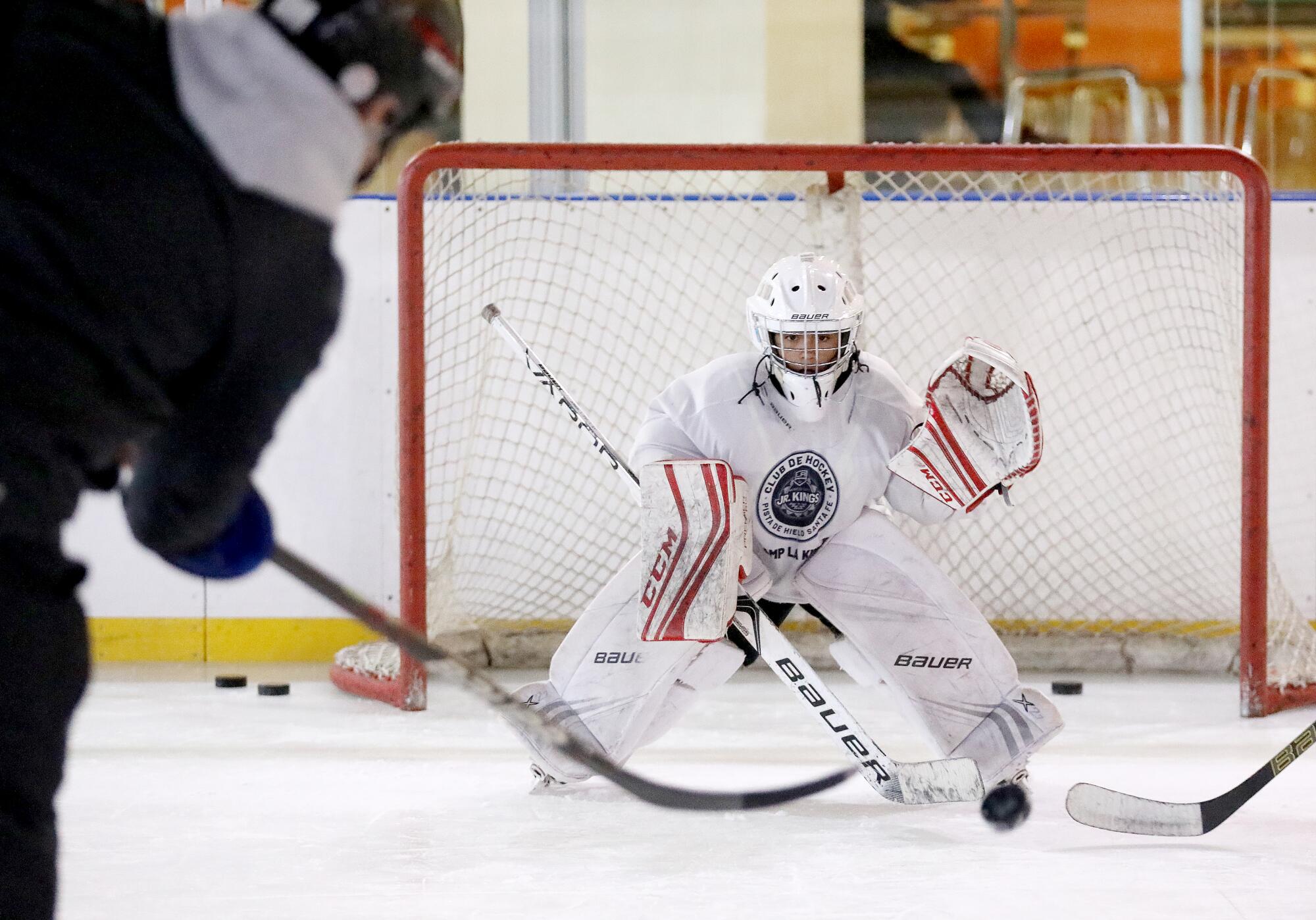
Instructions and encouragement — vámonos! vámonos! dále! dále! — ring out in Spanish, although most of the hockey terms, like stick and puck, go untranslated.
What the Kings want to create, then, is hockey with a Mexican accent and Latin sensibility. They’re not looking to import a sport wholesale but rather to create a hybrid. What they want are players such as 15-year-old Paula Martínez, one of two girls in the bantam age group — and one of 270 girls playing hockey nationwide, according to the federation.
She started skating at 3 and has been playing hockey with boys almost as long, tucking as much of her long brown hair inside her helmet as she can, then letting the rest spill down to her shoulders. Her friends, she said, don’t understand the game — or why she plays it.
“Every time you say you play hockey, they’re amazed. So you have to explain what it is. They think it’s only fighting, and it’s really not just that,” Paula said, flipping through cellphone photos of a trip to the University of Wisconsin, where she skated with members of the school’s women’s team.
“If I had to choose a sport again,” she said, “I would still choose hockey.”
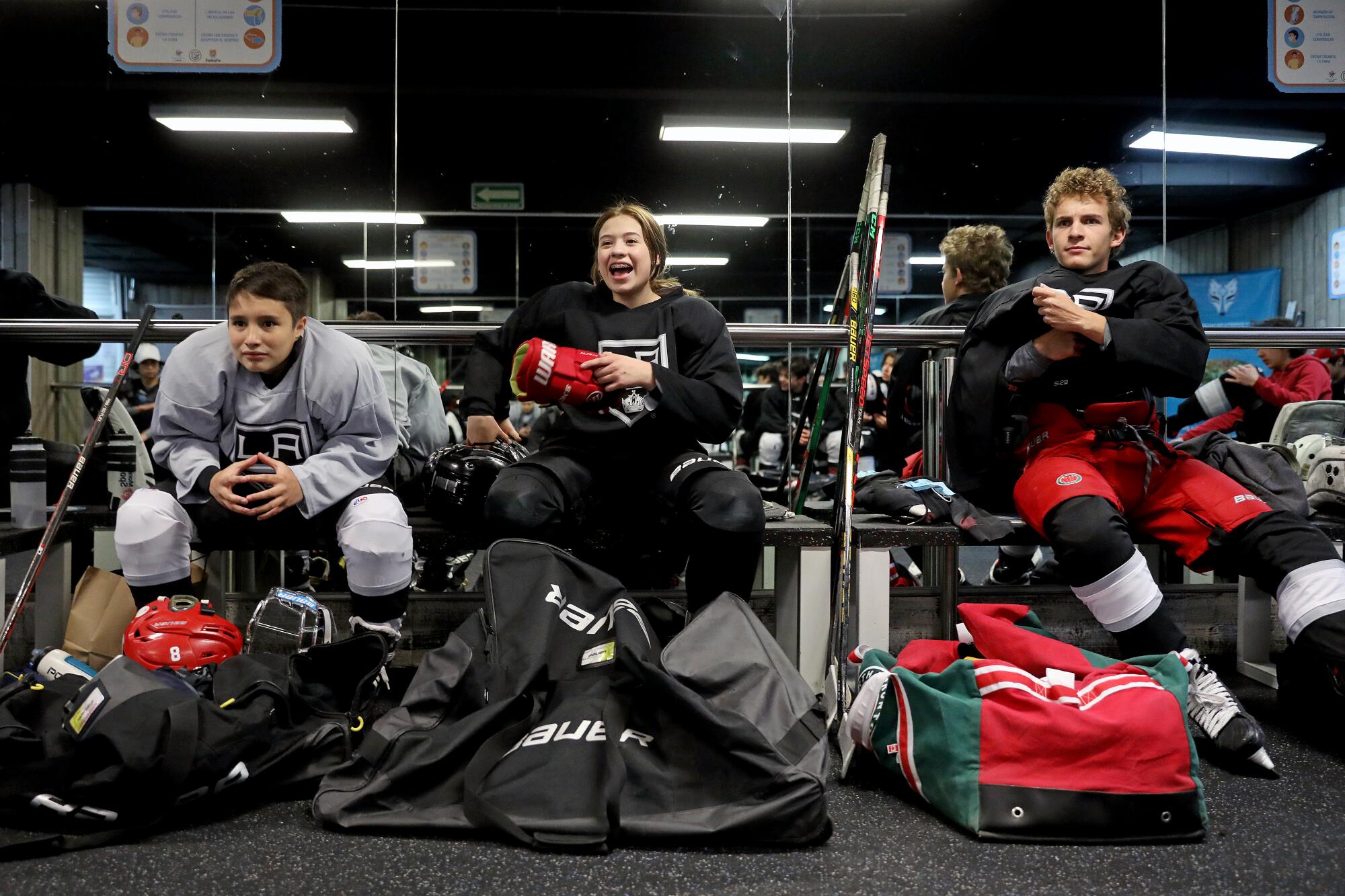
Many in Mexico don’t have that choice. Cost and access to an ice rink are major obstacles to hockey’s growth in Mexico.
Players in Guillermo Díaz’s program at the Santa Fe rink pay a $125 annual registration fee and $146 a month for instruction and ice time. That doesn’t include the brightly colored composite sticks, durable skates and other equipment such as pads and helmets, which can easily top $1,000 combined — more for goalies.
That’s well beyond the reach of most families in a country where the typical salary hovers around $17,000 a year. And while Mexico City has four rinks, there are just 14 in the rest of the country, according to the national ice hockey federation.
The level of play at the Santa Fe rink varies widely depending on the age group. On a recent Monday night, the peewees’ game, for kids 11 and 12, was so quick and well-played, dozens of shoppers stopped to peer down from the mall’s upper floors and watch.
With the Lakers and Clippers not even qualifying for the NBA playoffs, the Kings are L.A.’s final chance to have a team in the postseason this spring.
For the youngest players, meanwhile, simply staying upright and focused is the goal, which is why Díaz spent most of an hourlong practice simply trying to herd his toddler students into a straight line. During one drill, the players, many of whom wore blue COVID facemasks beneath their helmets, set off after the puck only to forget what they were supposed to do with it once they got it.
Kids pulled back their sticks, which were often bigger than they are, then shot at the wrong net, while others simply wandered away in the middle of a drill or skated into one another for no apparent reason. One boy brought his stick to shoulder level like a rifle and pretended to shoot teammates.
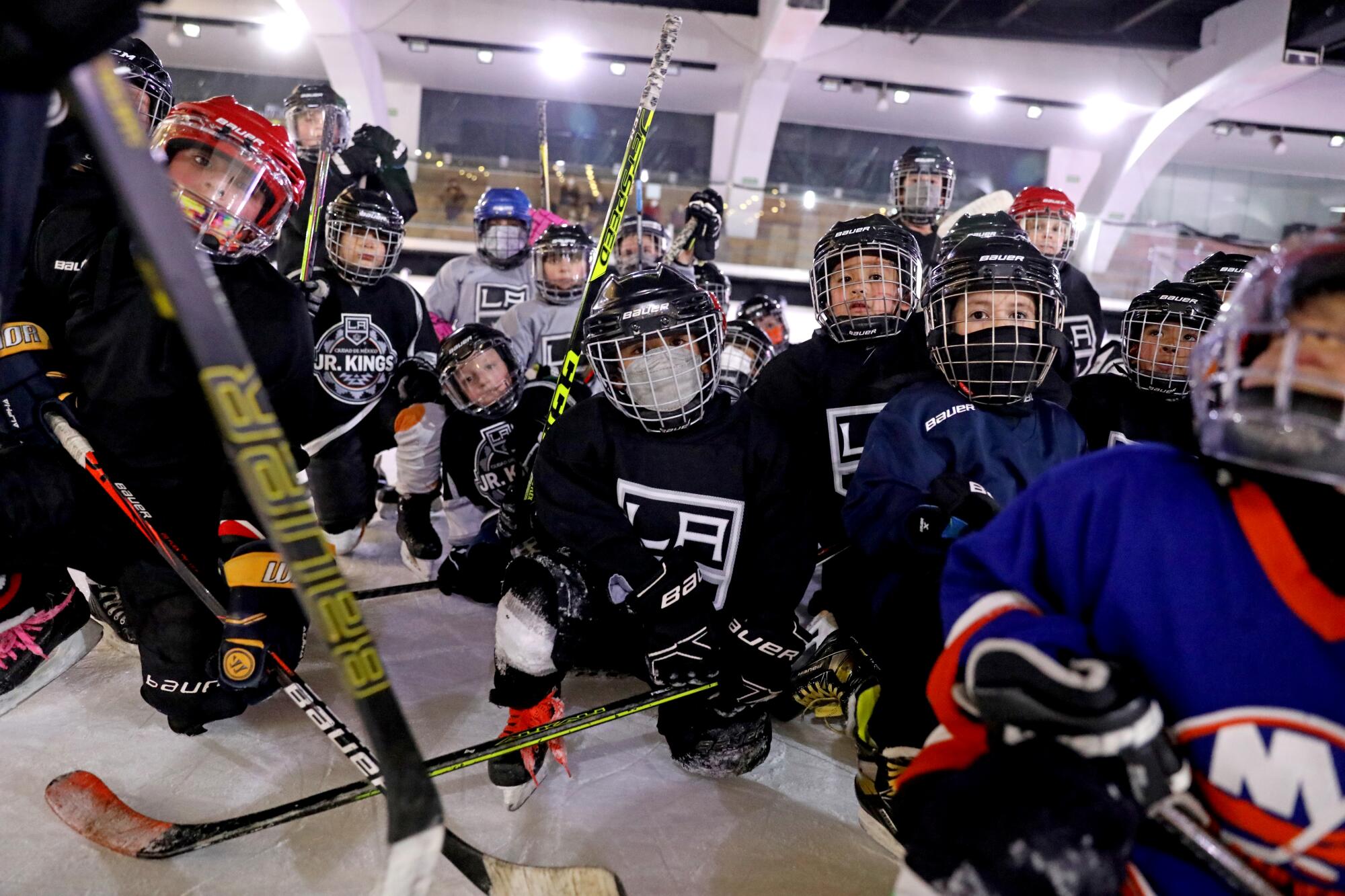
As for Ian, when he wasn’t whacking teammates in the head, he was often lying face down on the ice, the white No. 26 on the back of his jet-black jersey facing the Sears store a floor above.
“You have to invent some things,” González, the coach, said when asked how he kept the youngest players focused.
González’s time with the national team makes him an elite player in a country that has had few success stories to emulate in hockey. That could be changing.
Héctor Majul, who was lured away from a soccer field and into a Mexico City ice rink as a 6-year-old because his sister was a skater, followed his first coach to Arizona, where he attended high school. He practiced there alongside a local standout named Auston Matthews, whose mother was born in Mexico.
While Matthews went on to become the first overall pick in the 2016 NHL draft — and this season has broken the Toronto Maple Leafs’ franchise record with 58 goals — Majul played at Curry College in Massachusetts before being deported back to Mexico after his student visa was suspended.
That led to a nomadic journey that took him to hockey rinks and professional teams in Serbia, Lithuania, Finland and Italy. He will turn 28 next month, far too old to be considered a top prospect but not too old to give up his dream of becoming the first Mexican-born player to reach the NHL.
“Many times, being from Mexico causes people to assume that I can’t play hockey well and they don’t take me seriously until they see me play,” said Majul, who had a career-high 21 goals and 19 assists in 22 games this season for Como in Italy’s second-tier hockey league. “They wonder how it’s possible, which makes me laugh.
“I do think if I was Canadian or American, I definitely would have had better opportunities. But at the same time, it’s part of being the first Mexican to play at the level I’m playing and breaking the mental barrier that the hockey world has of not accepting players who don’t come from countries where hockey is popular.”
The kids at Centro Santa Fe might do even more to change that perception.
“Some of the kids here could play anywhere,” said Ross Wonnick, a Canadian transplant from Calgary whose son, Harrison, 9, just started playing at the rink.
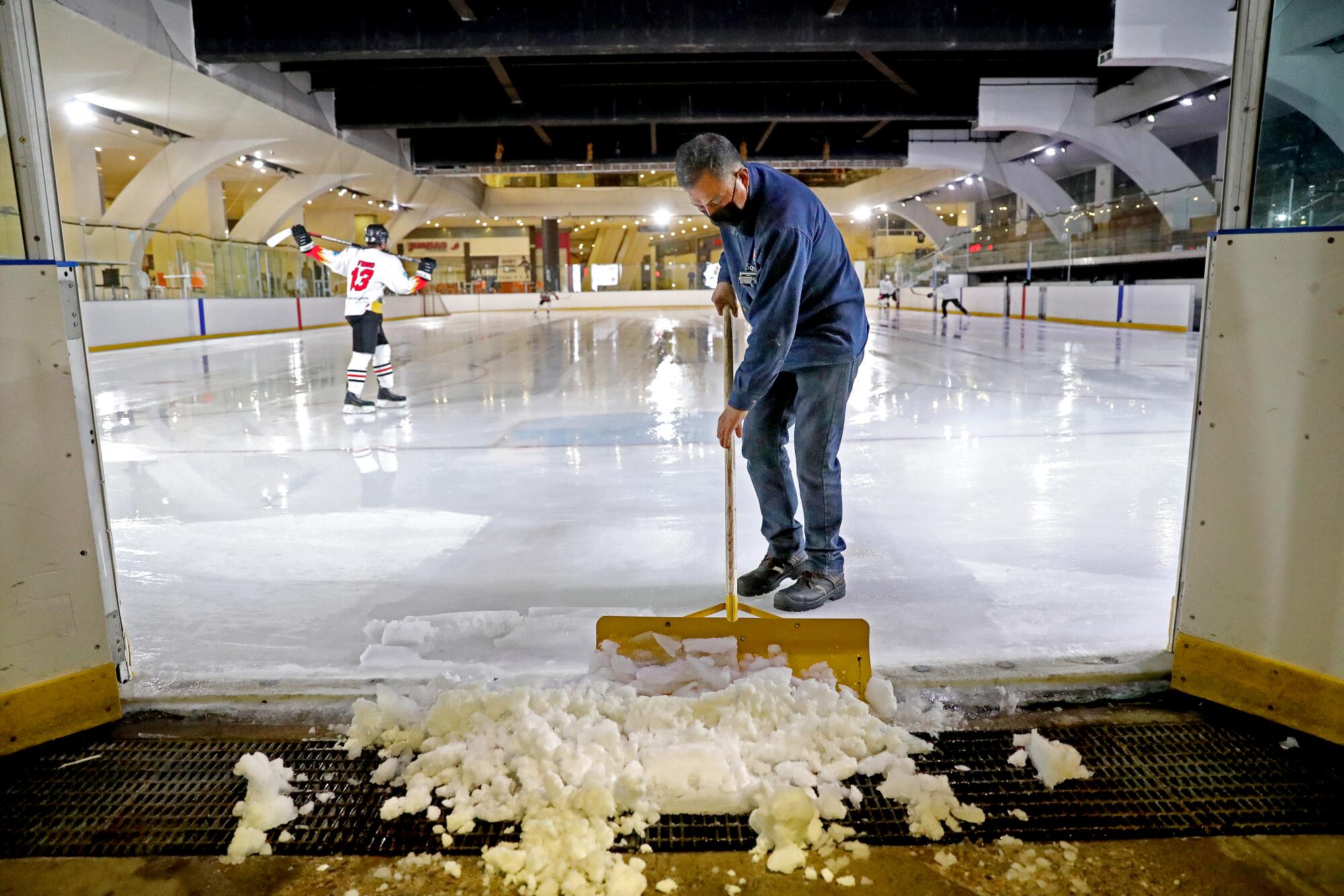
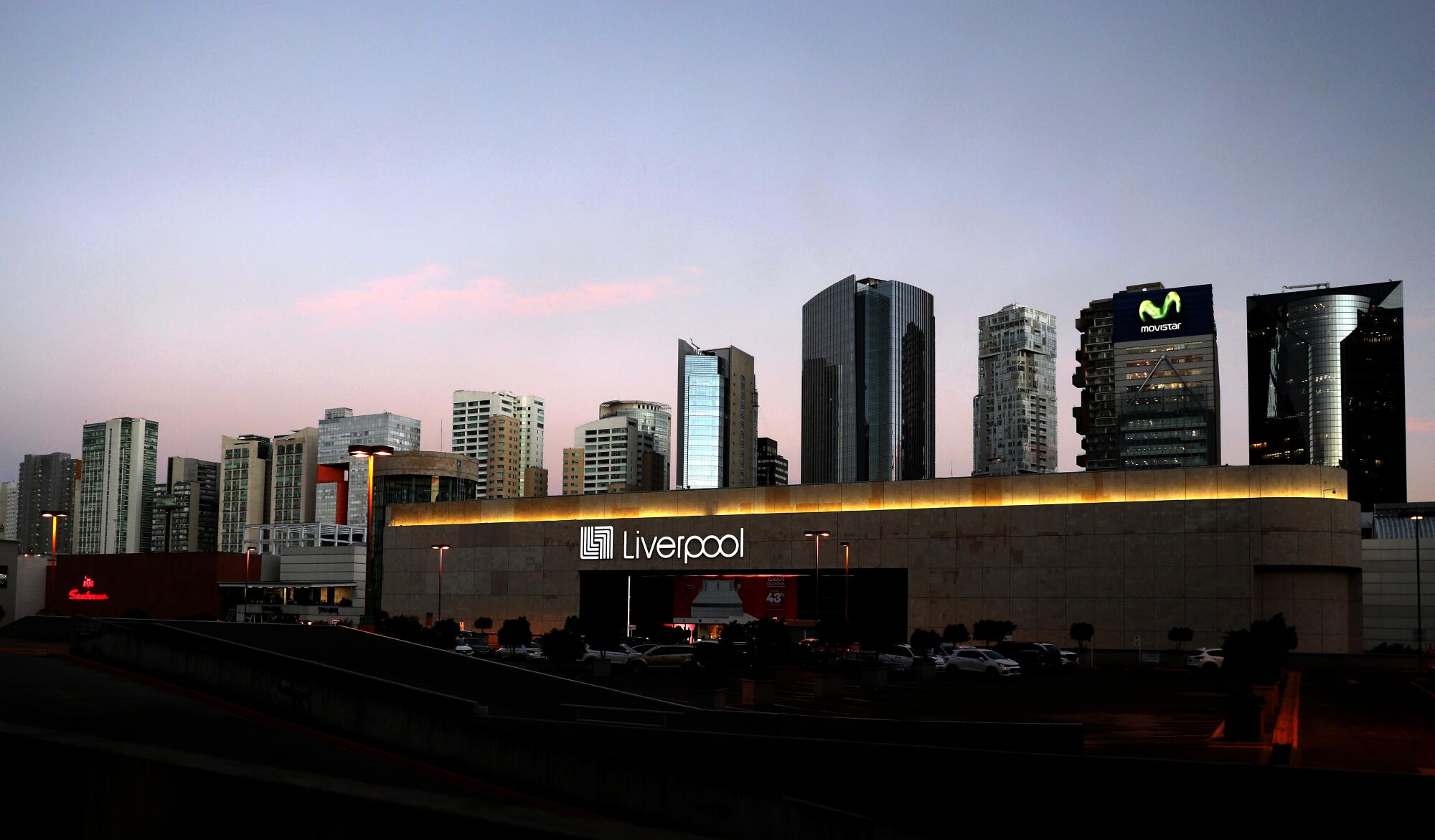
Yet the sport still seems a strange fit in a country that has nearly three times as many international airports as it does ice rinks — and the rinks that do exist are almost always jammed into a lightly trafficked nook of a shopping center.
“I think there’s only one ice rink that isn’t at a mall,” Paula, the 15-year-old center, said with a sigh.
Even so, Paula, her father, Francisco, a researcher at the National Autonomous University of Mexico, and dozens of other kids and parents crowd into the dark corner of the Centro Santa Fe as many as five nights a week. And the NHL has taken note.
“We’re definitely going down there to grow the game,” Robitaille, the Kings president, said. “That’s a no-brainer for a team like us, to help grow the game on the south side of the border.”
The team’s outreach to the Latino community began in Southern California but quickly reached south. Those efforts were stalled by COVID-19 but picked up again last fall when Armstrong went to Mexico City to put on a clinic.
Now other teams are following. The Dallas Stars, who play in a market that is more than 40% Latino, have begun broadcasting their games on Spanish-language radio and are developing a relationship with the Mexico Ice Hockey Federation.
“We’re trying to be Mexico’s team,” said Stars President Brad Alberts, who sees that effort as targeting Mexicans and Mexican Americans on both sides of the border in much the same way football’s Dallas Cowboys did. That team now has a license from the NFL allowing it to expand its home marketing base into Mexico.
“We look at it as a long-term, authentic community investment,” Alberts said. “We’re going to look at the Hispanic community in a much different way that we have ever before.”
At some point, Alberts said, that will mean playing a regular-season game in Mexico, as the three other major U.S. pro sports leagues have done. The Kings and Arizona Coyotes have also acknowledged similar hopes.
“We look at [Mexico] as an untapped market,” Alberts said. “We’re trying to capitalize now.”
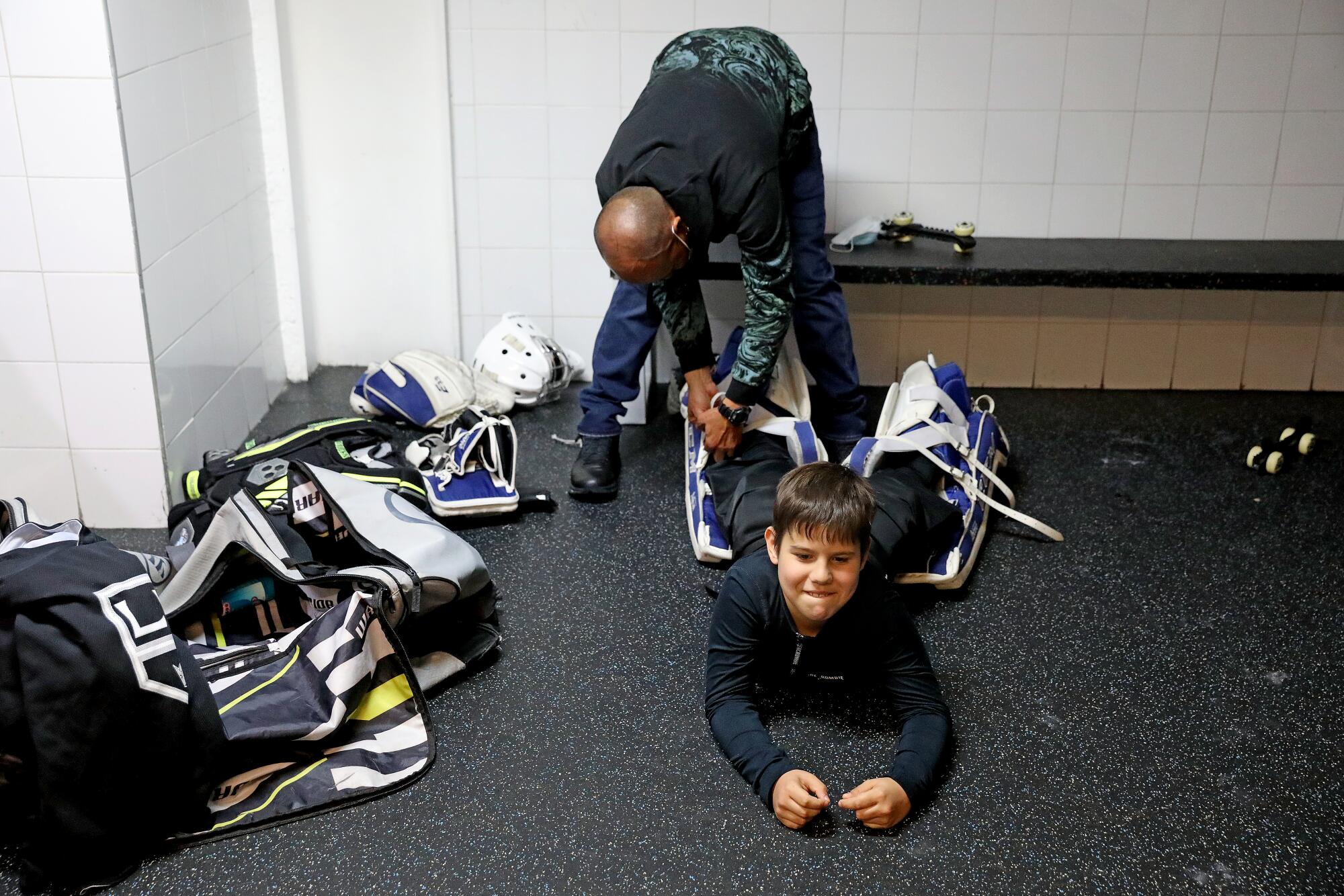
Back at the Santa Fe rink, it’s apparent Alberts’ timing is right. Kids roll in from the covered parking lot wearing hockey uniforms and riding in-line skates, their parents following behind carrying heavy equipment bags and hockey sticks.
“Saturdays, we stay here from 12 o’clock until nighttime,” said Cindy Rojas, the mother of an excitable rosy-cheeked 5-year-old named Sebastian, whose black No. 17 Kings jersey fits him like a tunic. “I can see that he enjoys it. That’s why it doesn’t matter if we have to come four or five times per week or stay here more than 10 hours.
“It doesn’t matter because I love when he’s happy.”
More to Read
Go beyond the scoreboard
Get the latest on L.A.'s teams in the daily Sports Report newsletter.
You may occasionally receive promotional content from the Los Angeles Times.


